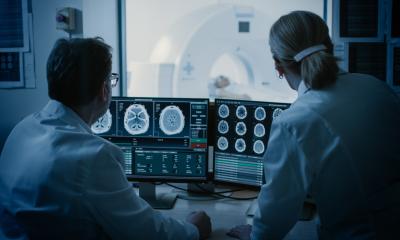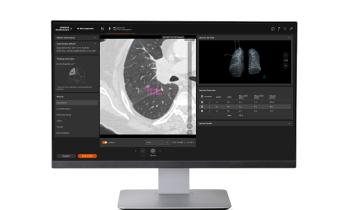Image source: Adobe Stock/zapp2photo
News • Joint considerations
Radiology societies address AI implementation in medical imaging
In a collaborative effort aimed at providing comprehensive insights into the integration of Artificial Intelligence (AI) in radiology, five leading radiology societies have published a joint paper addressing the potential challenges and ethical concerns related to this new technology.
The joint statement, issued by the American College of Radiology (ACR), Canadian Association of Radiologists (CAR), European Society of Radiology (ESR), Royal Australian and New Zealand College of Radiologists (RANZCR), and Radiological Society of North America (RSNA), can be accessed via the ESR’s online gold open access journal Insights into Imaging.
The paper underscores the dual impact of AI, presenting both revolutionary advances in healthcare practices and the imperative need for critical evaluation to distinguish between safe and potentially harmful AI tools. The key points emphasise the necessity for increased monitoring of AI utility and safety, advocating for collaboration among developers, clinicians, and regulators to navigate ethical concerns and ensure responsible AI integration into radiological practice. In addition, the statement also provides valuable insights for stakeholders, offering guidelines on evaluating stability, safety, and autonomous functionality, making it an indispensable resource for the development and implementation of AI in radiology.
This paper is not just a statement; it is a commitment to ensuring the responsible and effective use of AI for the betterment of patient care
Adrian Brady
Speaking about the paper, Lead Author and Chair of the ESR Board of Directors, Prof. Adrian Brady stated, “This paper is critical in ensuring that radiologists can define, enhance and safeguard the future of medical imaging. As AI becomes increasingly integrated into our field, it brings both tremendous potential and challenges. By addressing practical issues, ethical concerns, and safety considerations, we aim to guide the development and implementation of AI tools in radiology. This paper is not just a statement; it is a commitment to ensuring the responsible and effective use of AI for the betterment of patient care. It sets the stage for a new era in radiology, where innovation is balanced with ethical considerations, and patient outcomes remain our top priority.”
The collaborative effort demonstrated by the five societies signifies a united commitment to advancing the field of radiology and ensuring the responsible integration of AI technologies. “AI tools are an essential part of radiology's future,” said RSNA President Curtis P. Langlotz, M.D., Ph.D. “This statement [...] identifies key concerns that must be addressed to develop, implement, and monitor AI systems for clinical practice,” added Charles E. Kahn Jr., M.D., M.S., editor of Radiology: Artificial Intelligence.
AI carries the potential for unprecedented disruption in radiology with the possibility of both positive and negative consequences. The integration of AI in radiology could revolutionize healthcare practices by advancing diagnosis, quantification and management of multiple medical conditions. However, with the expanding availability and capabilities of AI tools in radiology comes an increasing need to critically evaluate claims for AI's utility and to differentiate safe product offerings from potentially harmful or fundamentally unhelpful ones.
Recommended article

Article • Technology overview
Artificial intelligence (AI)
With the help of artificial intelligence, computers are to simulate human thought processes. Machine learning is intended to support almost all medical specialties. But what is going on inside an AI algorithm, what are its decisions based on? Can you even entrust a medical diagnosis to a machine? Clarifying these questions remains a central aspect of AI research and development.
The multi‑society paper defines the potential practical problems and ethical issues surrounding the incorporation of AI into radiology practice. In addition to delineating the main points of concern that developers, regulators, and purchasers of AI tools should consider prior to their introduction into clinical practice, the statement also suggests methods to monitor the tools for stability and safety in clinical use, and to assess their suitability for possible autonomous function.
The multi‑society paper defines the potential practical problems and ethical issues surrounding the incorporation of AI into radiology practice. In addition to delineating the main points of concern that developers, regulators, and purchasers of AI tools should consider prior to their introduction into clinical practice, the statement also suggests methods to monitor the tools for stability and safety in clinical use, and to assess their suitability for possible autonomous function.
“This statement will serve as both a guide for practicing radiologists on how to safely and effectively implement and use the AI that's available today, and a roadmap for developers and regulators on how to approach delivering improved AI for tomorrow,” said statement co-author John Mongan, M.D., Ph.D., radiologist and vice chair of informatics in the Department of Radiology and Biomedical Imaging at the University of California, San Francisco, and chair of the RSNA Artificial Intelligence Committee.
The authors address a number of key issues surrounding the integration of AI into medical imaging workflow. They note that AI incorporation into clinical practice demands increased monitoring of its utility and safety. They also stress that cooperation between developers, clinicians and regulators is critical, to allow all involved to address ethical issues and monitor AI performance.
AI can fulfill its promise to advance patient well‑being if all steps from development to integration in health care are rigorously evaluated. This multi-society statement provides guidance for developers, purchasers and users of AI in radiology to ensure that the practical issues that surround all stages of AI from conception to long-term integration in healthcare are clear, understood and addressed, and that patient and societal safety and well-being are the primary drivers of all decisions.
Source: European Society of Radiology / Radiological Society of North America
24.01.2024










